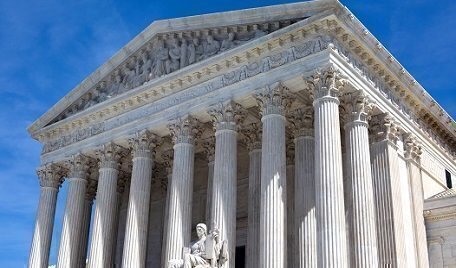Continuing its pattern of refusing to clarify the gun rights that are protected by the Second Amendment, the Supreme Court has turned aside a claim that gun merchants have their own constitutional right to sell firearms. An appeal in a California case was the first to ask the Justices to expand the Amendment to protect the seller side of gun transactions.
 Since its first two rulings, in 2008 and 2010, recognizing an individual right to have a gun, the Court has refused review of every case asking the Justices to spell out how far that Second Amendment right to a gun extends. Most importantly, it has refused to answer even the most basic follow-up question: since the original rulings only explicitly protected a right to have a gun for self-defense in one’s own home, does that right exist outside the home?
Since its first two rulings, in 2008 and 2010, recognizing an individual right to have a gun, the Court has refused review of every case asking the Justices to spell out how far that Second Amendment right to a gun extends. Most importantly, it has refused to answer even the most basic follow-up question: since the original rulings only explicitly protected a right to have a gun for self-defense in one’s own home, does that right exist outside the home?
Until now, the would-be sequel cases had all involved the rights of gun customers or owners. But a brief order issued by the Justices on Monday denied review, without an explanation, of a plea by gun rights advocates for the Court to recognize a Second Amendment right to sell guns, independent of any buyer’s right of access to such weapons.
A federal appeals court, the U.S. Court of Appeals for the Ninth Circuit, flatly rejected that idea, upholding the denial of a business license to a group of individuals who wanted to open a new “full-service” gun dealership between Hayward and San Leandro in Alameda County. There were already ten gun shops operating in the county, but the group backing the proposed Valley Guns and Ammo store contended that none of those would offer as full a range of supplies and services as their facility would.
The Ninth Circuit Court conceded that gun purchasers themselves do have a right to buy a gun and ammunition; otherwise, it said, their Second Amendment right would not be a real one. “A right to possess,” it said, “implies a corresponding right” of access to guns and bullets.
Although it concluded that would-be buyers in the county would have ample opportunity to shop for firearms in the existing stores, the Ninth Circuit Court did not base its decision against a new right-to-sell on that commercial situation.
Instead, it took on directly the question of whether there is a stand-alone right to sell guns under the Second Amendment, and concluded that there is not.
The planners of the new store, the Circuit Court said, were arguing that “even if there were a gun store on every square block” in the county, the new merchants would still have a Second Amendment right to set up their shop.
After making an extended review of court rulings on the Second Amendment and on the history of gun rights, the Circuit Court decided that “the Second Amendment does not confer a free-standing right, wholly detached from any customer’s ability to acquire firearms, upon a proprietor of a commercial establishment to sell firearms. Commerce in firearms is a necessary prerequisite to keeping and possessing arms for self-defense, but the right of gun users to acquire firearms legally is not coextensive with the right of a particular proprietor to sell them.”
In fact, the Circuit Court said, the Supreme Court’s first opinion establishing a personal right under the Second Amendment to have a gun, in 2008, had said explicitly that nothing in that ruling cast doubt “on laws imposing conditions and qualifications on the commercial sale of arms.”
The decision was made by a full “en banc” court of 11 judges; there were two dissents.
In taking the case on to the Supreme Court, an Alexandria, VA, lawyer often involved in Second Amendment cases, Alan Gura, argued that the Circuit Court was wrong in splitting Second Amendment rights into a right to acquire and a right to sell.
“As a logical matter,” the petition contended, “commerce inherently involves buyers as well as sellers, who may have equal constitutional rights in the transaction.”
Alameda County, defending the zoning ordinance and the business denial in this case, argued that the issue of whether there was a Second Amendment right to sell guns would only arise in a specific factual situation where local laws restricted gun sales completely, or nearly completely, so that the customer’s right of access would not exist as a real-world matter. Thus, it contended, when there is a “robust existing market” for guns, as it said there is now in Alameda County, there is no real risk to customers’ right of access to fulfill their right to a gun.
Although the Supreme Court does not give reasons why it turns down any appeal without review, it could be that a contributing factor in this case was that there is no dispute among lower courts on the question of whether the Second Amendment includes a right to sell firearms.
But, since the Court now has such a well-established pattern of declining to reenter the constitutional debate over the Second Amendment’s scope, it is also possible that the Justices simply have not yet found a need to oversee what the lower courts are doing.
Justice Clarence Thomas has been particularly critical of the Court for not agreeing to hear new cases on gun rights, but it takes the votes of four Justices to grant review, and that combination has not yet emerged.







